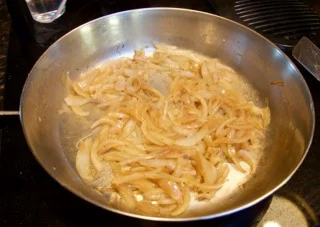I have never met an onion that I didn't like, but I know that not everyone shares that sentiment. My kitchen is nearly unusable if there are no onions. I think onions improve most dishes - raw or cooked depending on the circumstances. Let's start by talking about the differences between them.
Types of onions
There are differences in the members of the onion family. Green onions, also called scallions, and chives are the mildest and are usually eaten raw.
Red onions can also be eaten raw, but soaking them in water takes away some of the bite when they are used raw in salads. The color can be off-putting when cooked especially in pasta dishes where the cooked red onion sometimes takes on a grayish hue. Shallots are a good substitute for red onions or for any occasion that needs a mild taste. They are fairly expensive however.
There is a variety of sweet onion that includes such names as Vidalia, Walla Walla, and Maui. These can also be eaten raw as they have little to no sharp bite. They are more perishable and should be used quickly or stored in the refrigerator.
Yellow onions are my favorite and a staple in my kitchen. They are have both acidic and sweet characteristics. They are perfect for caramelizing. Spanish onions, a type of yellow onion, are even sweeter.
White onions have a sharp taste and are best when cooked. Mexican cooking, however, uses the white onion specifically because of their strong taste. Think about pico de gallo, salsas, and guacamole. These dishes call for an assertive taste, and the white onion provides this.
Garlic and leeks are also members of the onion family, but are irrelevant to this discussion.
How do onions improve a dish
When I travel and have access to a kitchen, I always buy an onion. Recently I was in a situation where I had access to a kitchen, but little time and ingredients. So, I went to the grocery, actually a gas station/grocery, and bought a frozen pizza, an onion, and good-quality cheese. Yes, a gas station actually sold onions and cheese, but this is Wisconsin! Adding slivered onions and freshly grated cheese dramatically improved the pizza. It was a lovely meal because of the surroundings. Sometimes you can't have a gourmet meal, but you can make the most out of what is available.
Why should I caramelize onions
If I would have had the time to caramelize onions, the pizza would have been even better. Caramelized onions add depth and sophistication to a dish. Not every dish needs this addition, but an ordinary dish can become great. Let's look at some examples.
French onion soup is popular in many restaurants in the US. The first step to making it is caramelizing onions. I also see hamburgers with caramelized onions on menus. Look at my recipe for Grilled cheese sandwiches. One variation adds caramelized onions. Use them on pizzas or tarts or in sandwiches. Adding caramelized onions does not necessarily make it a heavy dish, but it does add depth. Caramelized onion, blue cheese, and arugula pizza is an excellent example of this. This pizza is full of flavor, but is light and elegant.
How do I caramelize onions
Little equipment and few ingredients are needed. A heavy skillet with a lid and a metal spatula are all that are necessary. Three yellow onions, vegetable oil, salt, sugar, and water are the only ingredients. The times under the pictures are for the minutes into the process.
The first thing to do is to peel the onions.
Cut the onions in half through the root end and slice into 1/3-inch slivers. The onions should not be too thin because they will burn easier. You want the onion to have some density at the end. If your eyes are sensitive, I suggest using rubber googles, especially when you are slicing a lot of onions. They may look silly, but they work!
Add the vegetable oil and slivered onions to the skillet. Toss to coat the onions with the oil. Turn the heat to medium-high. Turning the heat on after the onions are in the skillet will prevent premature browning. Sauté the onions until they sizzle, about 1 minute, and turn the heat down to medium. Cook until they start to shrink and become soft, about 4 minutes. Add the salt and sugar. Stir.
When the onions start to brown, add 1/2 cup of the water and stir. Scrape any browned bits from the bottom of the pan.
When the liquid starts to simmer, cover the pan, and turn the heat to medium-low. Continue cooking, stirring about every 2 minutes to make sure the onions are not burning, about 9-10 minutes until most of the liquid has evaporated.
Remove the lid and return the heat to medium. Add more water, 1 tablespoon at a time, as necessary to keep the onions from burning. Frequent stirring is necessary as is scraping off the spatula.
Continue cooking and stirring until the onions are a deep caramel color, about 30 minutes from the time they were put into the skillet.
At this point, the onions are caramelized, but you could keep going to make them even more brown. I like a little texture left in them, but for French onion soup I would continue to cook them to get the deepest color I could without burning them. At this point, you could add 1 teaspoon of sherry to add more complexity, but it's really up to you.
How to store caramelized onions
When you take the time to make caramelized onions, it is easy enough to double this recipe. From the pictures you can see that there is a lot of room available in the pan. So, double or triple the recipe. It may take more time, but no more effort once the onions are peeled and slivered. Freeze in small amounts in ice cube trays, put the cubes in a resealable bag once they are solid, or in larger amounts in resealable bags.
Refer to Caramelized onions for a simplified recipe.

















